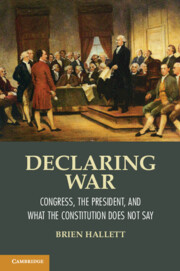Book contents
- Frontmatter
- Contents
- List of Figures
- Acknowledgments
- Prologue
- Miscellaneous Frontmatter
- 1 A Constitutional Tyranny and Presidential Dictatorship
- Part I What Is the History?
- Part II What Is a Declaration of War?
- 5 Declaring and Commanding
- 6 Lawful and Unlawful Declarations of War
- 7 Six Possible Structures
- Part III What Are the Solutions?
- Part IV What Is the Theory?
- Appendix I Five Congressional Declarations of War and One Appropriations Act
- Appendix II The Fœderative Powers in Parliamentary Governments
- References
- Index
7 - Six Possible Structures
Published online by Cambridge University Press: 05 November 2012
- Frontmatter
- Contents
- List of Figures
- Acknowledgments
- Prologue
- Miscellaneous Frontmatter
- 1 A Constitutional Tyranny and Presidential Dictatorship
- Part I What Is the History?
- Part II What Is a Declaration of War?
- 5 Declaring and Commanding
- 6 Lawful and Unlawful Declarations of War
- 7 Six Possible Structures
- Part III What Are the Solutions?
- Part IV What Is the Theory?
- Appendix I Five Congressional Declarations of War and One Appropriations Act
- Appendix II The Fœderative Powers in Parliamentary Governments
- References
- Index
Summary
The Congress shall have power … to declare war, grant letters of marque and reprisal, and make rules concerning captures on land and water.
(article I, section 8, clause 11)It may well be that the problem of “democracy,” construed as an ideal, cannot be solved until there is a solution to the problem of war.
(Peter Manicas 1989, 1)A review of the six possible procedures or structures for declaring war is needed before proposing solutions. The purpose of the review is to capture the full range of possible alternatives. In passing, though, the story of how successive presidents have radically reduced the amount of time that the Congress devotes to the declaring of war may prove of some interest. During the nineteenth century, the stiff resistance of the Jefferson Republicans meant that the Twelfth Congress took essentially its entire seven-month session, from 4 November 1811 until 18 June 1812, to find the votes needed for passage of Secretary Monroe’s State Department–drafted declaration. In 1898, efficiency grew exponentially. Under expedited rules, the Fifty-fifth Congress took, not seven months, but seven days, 13–19 April 1898, to pass the conditional declaration against Spain and less than a day to pass the absolute declaration on 25 April 1898, after the commencement of armed hostilities.
During the twentieth century, President Wilson achieved moderate gains in efficiency by calling a special session. During the session, the Sixty-fifth Congress followed the regular peacetime procedures to amend slightly and then pass the State Department’s resolution in three days, between 2 and 5 April 1917 (Elsea and Grimmett, 2006, 77–9). However, President Roosevelt achieved the greatest gains in efficiency when the Seventy-seventh Congress completed the whole process in three hours and forty minutes on 8 December 1941. The president spoke to a joint session from 12:30 pm until 12:36:06 pm. The Senate returned to its chamber and both houses suspended the rules so as to pass the State Department–drafted resolution in thirty-three minutes, by 1:09 pm. It took until 3:23 pm to prepare the paperwork, and President Roosevelt approved the declaration at 4:10 pm (Kluckhohn 1941, 1).
- Type
- Chapter
- Information
- Declaring WarCongress, the President, and What the Constitution Does Not Say, pp. 146 - 160Publisher: Cambridge University PressPrint publication year: 2012



